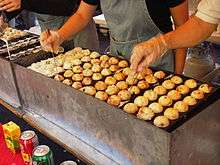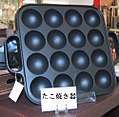Takoyaki
 A boat of takoyaki | |
| Course | Snack or appetizer |
|---|---|
| Place of origin | Japan |
| Region or state | Japanese-speaking areas |
| Main ingredients | batter, octopus, tempura scraps (tenkasu), pickled ginger, green onion |
| Variations | Taiwanese cuisine |
Takoyaki (たこ焼き or 蛸焼) is a ball-shaped Japanese snack made of a wheat flour-based batter and cooked in a special molded pan. It is typically filled with minced or diced octopus (tako), tempura scraps (tenkasu), pickled ginger, and green onion.[1][2] Takoyaki are brushed with takoyaki sauce (similar to Worcestershire sauce) and mayonnaise, and then sprinkled with green laver (aonori) and shavings of dried bonito. There are many variations to the takoyaki recipe, for example, ponzu (soy sauce with dashi and citrus vinegar), goma-dare (sesame-and-vinegar sauce) or vinegared dashi.
Yaki is derived from "yaku" (焼く) which is one of the cooking methods in Japanese cuisine, meaning "to fry or grill", and can be found in the names of other Japanese cuisine items such as okonomiyaki and ikayaki (other famous Osakan dishes).[3]
History
Takoyaki was first popularized in Osaka,[4] where a street vendor named Tomekichi Endo is credited with its invention in 1935. Takoyaki was inspired by akashiyaki, a small round dumpling from the city of Akashi in Hyōgo Prefecture made of an egg-rich batter and octopus.[5] Takoyaki was initially popular in the Kansai region, and later spread to the Kantō region and other areas of Japan. Takoyaki is associated with yatai street food stalls, and there are many well-established takoyaki specialty restaurants, particularly in the Kansai region. Takoyaki is now sold at commercial outlets, such as supermarkets and 24-hour convenience stores.
It is also very popular in Taiwanese cuisine due to the historical influence of Japanese culture.[6]
Takoyaki pan
A takoyaki pan (たこ焼き器 takoyaki-ki) or—much more rarely—takoyaki-nabe (たこ焼き鍋) is typically a griddle made of cast iron with half-spherical moulds.[2] The heavy iron evenly heats the takoyaki, which are turned with a pick during the cooking process to pull the uncooked batter to the base of the rounded cavity. Commercial gas-fueled takoyaki cookers are used at Japanese festivals or by street vendors. For home use, electric versions resemble a hotplate; stovetop versions are also available.
Image gallery
 Cooking takoyaki
Cooking takoyaki Takoyaki served with Japanese Worcester sauce and mayonnaise
Takoyaki served with Japanese Worcester sauce and mayonnaise
 A takoyaki yatai in Yoyogi Park, Tokyo
A takoyaki yatai in Yoyogi Park, Tokyo Square takoyaki pan with 16 molds
Square takoyaki pan with 16 molds.jpg) Open kitchen store
Open kitchen store
See also
- Similar global dishes
- Æbleskiver in Denmark
- Poffertjes in Netherlands
- Unni appam, Neyyappam and Paddu in South India
References
- ↑ "蛸焼" [Takoyaki]. Dijitaru daijisen (in Japanese). Tokyo: Shogakukan. 2012. OCLC 56431036. Archived from the original on 2007-08-25. Retrieved 2012-06-22.
- 1 2 "Takoyaki". Encyclopedia of Japan. Tokyo: Shogakukan. 2012. OCLC 56431036. Archived from the original on 2007-08-25. Retrieved 2012-06-22.
- ↑ Takiyaki, the great street snack
- ↑ "蛸焼" [Takoyaki]. Nihon Kokugo Daijiten (in Japanese). Tokyo: Shogakukan. 2012. OCLC 56431036. Archived from the original on 2007-08-25. Retrieved 2012-06-17.
- ↑ Takoyaki - Icon of Osaka
- ↑ "In Taiwan, top chefs are building on a long history of culinary exchange with Japan", The Japan Times. Retrieved 2018-02-28.
External links
| Wikimedia Commons has media related to Takoyaki. |
- Making Classic Takoyaki at Home A DIY Takoyaki recipe.
- gindaco
